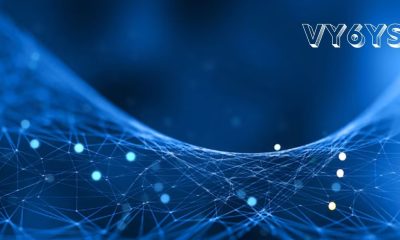TECHNOLOGY
How Microsoft Cloud Can Improve Collaboration in Your Business

Introduction
Any successful organization is built on effective collaboration. Smooth communication and teamwork are essential in today’s hectic business world to sustain productivity and meet organizational objectives. Cloud solutions can significantly improve collaborative efforts by removing obstacles and promoting a more connected work environment. Microsoft Cloud is a potent tool with extensive features to enhance collaboration within your company. This article will explore how Microsoft Cloud can transform your team’s work.
Real-Time Communication and Document Sharing
One of Microsoft Cloud’s most notable features is its ability to enable real-time communication and document sharing. By utilizing cloud solutions Microsoft allows teams to collaborate on projects seamlessly, no matter where they are located. Tools like instant messaging, video conferencing, and synchronized document editing enable team members to communicate and work on documents simultaneously.
For instance, team meetings can be conducted virtually with high-quality video calls, enabling participants to share their screens and discuss project details in real-time. Cloud storage of documents enables team members to access and edit them concurrently, eliminating the need for drawn-out email exchanges and guaranteeing that everyone agrees. This real-time collaboration capability significantly reduces delays and enhances organizational efficiency.
Integration with Existing Tools and Systems
Microsoft Cloud integrates with various business tools and systems, enhancing productivity and streamlining workflows. Whether it’s project management tools, CRM systems, or data analytics platforms, Microsoft Cloud ensures that all your essential tools can work together harmoniously. Because there is no longer a need to flip between apps, employees can spend less time on administrative duties and more time on their primary responsibilities.
For example, project managers can integrate cloud-based project management software with Microsoft Cloud, providing real-time updates on project progress and allowing team members to collaborate more effectively. Sales teams can connect their CRM systems with cloud services, ensuring customer data is always up to date and accessible during client interactions. This level of integration creates a unified digital workplace where all relevant information is readily available, improving decision-making and overall efficiency.
Enhanced Security Features
Security is a top priority for collaboration, especially when sharing sensitive information. Microsoft Cloud offers robust security features to protect your data during cooperation. These features include encryption, multifactor authentication, and regular security updates to safeguard your information from unauthorized access.
For instance, sensitive documents can be encrypted during transmission and at rest in the cloud. Multifactor authentication provides an additional layer of security by requiring users to authenticate their identity using multiple methods before granting access. Regular security updates ensure that your cloud environment remains protected against emerging threats. By prioritizing security, Microsoft Cloud allows teams to collaborate confidently, knowing their data is safe and secure.
Scalability and Flexibility
Because of its excellent scalability and flexibility, Microsoft Cloud can accommodate companies of all sizes and changes to meet their evolving needs. Cloud solutions can quickly scale up or down to meet your needs, regardless of whether your company is experiencing rapid growth or downsizing. Scalability like this is especially helpful for companies whose workloads change frequently.
For instance, a rapidly expanding startup doesn’t have to make significant upfront investments in IT infrastructure because it can quickly scale its cloud resources to meet growing demand. Conversely, during periods of reduced activity, businesses can scale down their cloud usage, paying only for the resources they need. This flexibility ensures your organization can remain agile and responsive, adapting to market changes and business demands without disruption.
Improved Remote Collaboration
Effective collaboration among geographically dispersed teams has become more critical with the increasing remote work trend. Microsoft Cloud provides a robust platform for remote collaboration, allowing employees to work together seamlessly from different locations. Remote team members can create, edit, and share documents in real time, participate in virtual meetings, and stay connected through instant messaging.
For example, a marketing team across different cities can collaborate on campaign strategies, share creative assets, and receive real-time feedback using cloud-based tools. Employees working from home can access the same resources as their office-based counterparts, ensuring consistency and productivity. This improved remote collaboration capability fosters a more inclusive work environment, enabling organizations to tap into a global talent pool and maintain business continuity.
Conclusion
In conclusion, Microsoft Cloud offers a comprehensive suite of features that significantly enhance business collaboration. Cloud solutions enable teams to collaborate more successfully and efficiently through robust security measures, smooth integration with current tools, real-time communication, and document sharing. Microsoft Cloud’s scalability and flexibility guarantee that your company can adjust to evolving demands, and its enhanced remote collaboration features foster the expanding trend of remote work.
Businesses can remove obstacles to communication, optimize workflows, and create a more cohesive and effective work environment by utilizing the power of Microsoft Cloud. Whether you’re a small startup or a large enterprise, embracing cloud solutions can revolutionize how your teams collaborate, driving success and innovation in today’s competitive business landscape.
TECHNOLOGY
RAPELUSR: The Digital Mirage That’s Redefining Online Identity

In the age of digital illusions and ever-shifting online terrains, new identities, terms, and domains flicker into existence like constellations only visible to those who know where to look. One such spectral phenomenon is “rapelusr.” On the surface, it’s a curious string of characters. Dive deeper, though, and you find a compelling case study in the evolution of online pseudonyms, digital subcultures, and internet linguistics.
“Rapelusr” isn’t a household name—yet. But in digital backchannels, discussion boards, content archives, and the more obscure corners of the net, it’s a keyword that raises eyebrows, triggers debates, and occasionally, confusion. This isn’t just a story about a term. It’s a journey into how the internet constructs meaning out of chaos—and how a term like rapelusr could end up being a cultural artifact of the 2020s.
Let’s break it down, decode its layers, and trace the contour of a keyword that might be more than just digital gibberish.
CHAPTER 1: What Is Rapelusr? Origins, Myths, and Metadata
The first question everyone asks: What does rapelusr mean?
A quick scan of search engines returns a cocktail of results—some content farms, strange user handles, tech blogs referencing it in cryptic tags, and language detection tools failing to identify its etymology. But here’s what we know: rapelusr is not a recognized word in any language. It’s not Latin, it’s not a misspelling, and it’s not just random.
It appears most prominently as a digital marker—possibly an autogenerated username, a project codename, or an invented tag for stealth SEO. Its earliest online footprints trace back to niche forums in late 2023, where it cropped up in metadata, image alt-text, and even as a watermark on AI-generated art. One user on a now-defunct subreddit described it as a “neural glitch”—a token produced during a dataset training loop that escaped into the wild.
Whether myth or metadata, the birth of rapelusr is rooted in the language of algorithms.
CHAPTER 2: The SEO Wildcard
Strange keywords often find purpose through search engine optimization (SEO). SEO experts live and breathe keywords—but what happens when a term like rapelusr appears out of thin air?
Initially, rapelusr functioned like digital whitespace—a keyword with no competition. Enterprising SEO tacticians quickly realized that creating content around this term offered a rare opportunity: guaranteed rank dominance. If you wrote about rapelusr, your page would likely show up on top simply because no one else was.
And so began the first wave of “rapelusr content farms”—dozens of autogenerated sites, blog snippets, AI-written pages, and video metadata entries with nothing but vague content using the keyword. Their goal? Drive traffic, monetize ad clicks, or build domain authority.
Some speculated these sites were part of black-hat SEO campaigns, designed to artificially inflate site relevance by exploiting the zero-competition landscape of rare keywords like rapelusr.
In essence, rapelusr became a ghost keyword—not searched for, not understood, but used for leverage.
CHAPTER 3: Rapelusr as Persona: Digital Doppelgängers
The next phase in the rapelusr lifecycle was more personified. Around early 2024, rapelusr began surfacing as a username, sometimes on coding repositories, other times in gaming communities. It started to gather mythos: was rapelusr a single hacker? A collective? An AI bot?
On GitHub, an account named “rapelusr” uploaded a series of Python scripts related to natural language generation. On Twitch, a user named “Rapelusr_tv” began streaming surreal, AI-crafted video loops with vaporwave soundtracks and no commentary. Viewers were baffled. Comments poured in:
“Who is this guy?”
“Is rapelusr a bot or just weirdly consistent?”
“I feel like this is some kind of ARG.”
The ambiguity only fueled the mystery. Like many internet legends, anonymity became its superpower. And in doing so, rapelusr transformed from keyword to avatar—a digital doppelgänger for anyone who wanted to shed their old identity and become part of the myth.
CHAPTER 4: A Linguistic Black Swan
In linguistic terms, rapelusr is a black swan. It defies roots, syntax rules, and semantic conventions. But that’s also what makes it fascinating.
Internet linguists (yes, they exist) suggest that rapelusr could be a nonce word—a term coined for one-time use but that sometimes gains traction. Think of “yeet” or “meme” in their early days. Rapelusr’s phonetic structure—sharp consonant start, fluid vowel core, abrupt close—gives it an almost brand-ready cadence.
It’s the kind of name that could be a startup, an app, a cryptocurrency, a pop band, or an alien AI in a sci-fi novel.
It’s also morphologically genderless, nationless, and timeless—qualities that give it remarkable adaptability.
CHAPTER 5: Subcultures and the Meme Machine
Once a term has ambiguity and a bit of mystery, it’s ripe for meme culture. Rapelusr has already begun that process.
There are now TikTok edits with glitchy rapelusr logos, “rapelusr-core” aesthetics on Tumblr (think neon decay + cyberpunk edges), and AI-generated fashion inspired by “the rapelusr look” (high collars, glass visors, synthetic textures). On Reddit, jokes abound:
“I put rapelusr in my coffee. Now I speak in QR codes.”
“My girlfriend left me for rapelusr. I can’t compete with a synthetic entity.”
It’s surreal, funny, and deeply telling of how the internet plays with language until meaning emerges—a meme becomes real because we believe it is.
CHAPTER 6: Branding the Unbrandable
Here’s the twist: rapelusr may have started as a fluke, but now it’s being treated as an untapped brand asset.
We’ve seen logos, merch drops, NFT art (yes, still), and domain purchases all anchored on rapelusr. Startups looking for a clean slate are eyeing it the way people once looked at terms like “Spotify” or “Google”—weird at first, but now part of the lexicon.
One Berlin-based tech collective even filed for a digital product trademark under the name RAPELUSR, aimed at launching “a decentralized creativity platform powered by neural net aesthetics.”
What began as noise is turning into brand strategy.
CHAPTER 7: Digital Identity and Anonymity in the Rapelusr Era
Stepping back, the rise of rapelusr isn’t really about the term itself. It’s about how we shape identity online—how we cloak ourselves in usernames, codes, keywords, and symbols to navigate digital landscapes that are increasingly commercial, chaotic, and surveilled.
Rapelusr has become a symbol of:
-
Pseudonymity: A username that anyone can wear.
-
Signal noise manipulation: Content that exists solely to manipulate algorithms.
-
Digital rebellion: A term without meaning, demanding to be taken seriously.
It represents the power of undefined identity in a world desperate to categorize everything.
CHAPTER 8: Where Do We Go From Here?
The story of rapelusr isn’t over. If anything, it’s only just begun. Its journey from ghost keyword to cultural cipher mirrors the arc of so many internet-born phenomena: oddball beginnings, chaotic growth, ironic memeing, and eventual legitimation.
What’s fascinating is that we are witnessing in real-time how language evolves in the algorithmic age. A term with no roots, no meaning, and no agenda can still become powerful—because we assign power to it.
So what’s next?
-
Will rapelusr become a tech brand?
-
A decentralized persona project?
-
An ongoing alternate reality game?
-
A case study in how SEO accidents can birth culture?
Whatever it becomes, one thing’s certain: rapelusr is no longer nothing. It’s something. A placeholder turned player. A whisper turned waveform.
FINAL THOUGHTS: The New Alphabet
In a world where words are currency, and keywords can make or break digital empires, something like rapelusr reminds us of the chaos under the code. It’s a digital Rorschach test—meaning whatever we need it to.
And in that way, rapelusr might just be the most modern word we’ve got.
It doesn’t belong to a language, a place, or a person.
It belongs to the internet itself.
TECHNOLOGY
5 Factors to Consider Before Buying Smart Home Devices

I’ve always been a big fan of smart home technology. Its convenience, automation, remote capability and other features have improved my life for good. With time, I’ve amassed a huge collection of smart home devices. But I’ve realized a few things along the way that I wish someone had told me before.
In this article, I highlight some factors that should be considered before buying a smart home gadget(s). If you are planning to buy a smart home gadget, keep reading this article before you make an informed decision about getting them. So, let’s start:
- Does it Solve the Real Problem?
- Is It Compatible with Other Devices?
- Is Your Internet Up for the Task?
- Are You Mindful of Privacy Concerns?
- Are You Aware of Security Concerns?
- Bonus Suggestions
Does it Solve the Real Problem?
I’ve bought a few smart-home devices that were more of a novelty than a necessity. And I’ve also bought some devices that I consider now as a life-saver. The difference between these two devices’ categories is that in the latter, I knew what I wanted from the devices.
When you’re shopping for smart home gadgets, ask yourself, “Why do I need it and how would this gadget help me streamline important tasks?”
For instance, if you forget to turn off lights when leaving the room, smart-lights may be the best option since they have a sensor built in. Or, if your mornings are always a rush-time, bringing in a smart coffee maker or a smart toaster would make sense.
So, whenever you plan to buy a smart home device, make sure you know what purpose it fulfills.
Is It Compatible with Other Devices?
Smart gadgets that you buy should be compatible with other devices. I learnt this lesson the hard way when I bought smart curtains, only to know that they wouldn’t integrate with my smart home assistant; Alexa. While I could manage my room lights and thermostat with Alexa, I had to open the smart curtain’s app to manage them. The smart curtains were not compatible with Alexa.
It’s best if you opt for smart devices that can be easily managed by a central hub. Because in the long run, managing multiple smart home devices from different apps becomes a struggle.
Is Your Internet Up for the Task?
I’ve been particularly ignorant of the fact that most smart gadgets require an active internet connection to work. And because of a spotty WiFi connection, my smart gadgets have malfunctioned more times than I can remember.
At best, an average internet may only cater to one or two smart home devices. And if you have a bunch of gadgets, make sure you have a reliable internet connection to support them.
My experience with Xfinity internet has been quite good so far. I was able to contact Xfinity customer support to learn how much internet I needed to ensure seamless flow of smart home devices along with my online activities.
Are You Mindful of Your Privacy?
Most smart home devices collect data about your habits and routines. The time you wake up, have breakfast, the music you listen to, the products you want to buy, and more, all of this information is collected by smart home gadgets.
While the purpose here is to customize the whole experience for users based on their needs, most companies may use this information to bombard you with tailored ads, or simply sell your information to a third-party vendor (usually advertisers).
Here, I’d advise you to read privacy terms before buying a gadget. You should know what information will the device collect, how you can control data sharing, or any red flags that may be harmful for your privacy.
Are You Aware of Security Concerns?
Besides privacy concerns, you should know that technological gadgets like smart home devices can be hacked into. In worst cases, you may not even realize when your smart home device(s) is being hacked.
The best way to avoid this situation is to buy smart home devices with advanced security features. Most gadgets have encryption and two-factor authentication (2FA) which acts as a security layer. Also, make sure to keep your smart gadgets updated with the latest security patch.
Bonus Suggestions
- Expand Slowly – Start with one or two smart home devices and get accustomed to technology. Then, expand gradually while keeping your needs in mind.
- Central Hub and Ecosystem – It’s best if you can find different smart home gadgets from same company. You can easily create a central hub to control all the devices and integrate them without any hassle.
- Setting Up a Device – It’s best to get an expert’s help if setting up a smart home device is not your cup of tea.
- Read Manuals – Some smart home devices have a lot of hidden functionality. That is why I recommend to skim through the device’s manual to know its true potential.
TECHNOLOGY
How to Assess the Solar Power Needs of Your Modern Ranch House

Assessing the solar power needs of your modern ranch house is key to creating an efficient and cost-effective system. From evaluating your energy usage to understanding your roof’s layout, there are several factors to consider. With the right information, you can save on electricity bills and reduce your carbon footprint.
In this post, we’ll share some helpful tips to guide you in planning the perfect solar setup for your modern ranch house. Read on and learn more.
Calculate Your Energy Consumption
Understanding how much energy your home uses is key to sizing your solar system. Look at your electricity bills from the past year to find out your average monthly energy consumption. This number will help you determine how many solar panels you’ll need.
Your energy consumption can fluctuate, especially with changes in seasons. For example, ranch houses in warmer areas may use more electricity for air conditioning. By knowing your energy usage, you can ensure your solar system will meet your needs year-round.
Determine Your Home’s Energy Efficiency
Before installing solar panels, it’s important to check how energy-efficient your home is. Look for areas where you can improve energy efficiency, such as better insulation or energy-efficient appliances. A more efficient home means you’ll need less solar energy to power it.
Improving energy efficiency can also help you save money in the long run. The less energy your home wastes, the less electricity your solar panels will need to generate. Simple upgrades like energy-saving windows or LED lights can make a big difference.
Understand Your Peak Sunlight Hours
Solar panels rely on sunlight to generate power, so it’s essential to know how much sunlight your home gets. The number of peak sunlight hours in your area will affect how well your solar system performs. Ranch houses, with their single-story layouts, often have good access to sunlight if there aren’t any large trees or buildings blocking the way.
You can check online tools or speak with a local solar expert to find out the average peak sunlight hours in your area. By knowing this information, you can better estimate how much solar energy your panels will be able to generate.
Check Your Roof’s Condition
Your roof is an important factor when installing solar panels. Make sure your roof is in good shape before moving forward with your solar project. If your roof needs repairs or is nearing the end of its lifespan, it’s best to address those issues first.
A sturdy roof ensures that your solar panels will stay securely in place for many years. If you’re unsure about your roof’s condition, consider having a professional inspect it to avoid costly issues down the road.
Assess Your Property’s Shading
Shading can reduce the amount of sunlight that reaches your solar panels, which impacts their efficiency. Check if there are any trees, buildings, or other structures that cast shadows on your roof during the day. Even partial shading can significantly reduce the performance of your solar system.
You may need to trim back trees or adjust where you place your solar panels to maximize sunlight exposure. Solar experts can help you figure out the best placement for your panels to avoid shading issues.
Consider the Size of the Solar System You Need
The system size you choose will depend on your energy consumption and how much sunlight your home gets. A larger system can produce more electricity, but it also takes up more space on your roof. On the other hand, a smaller system may be more affordable, but it may not generate enough energy for your needs.
Work with a solar expert to determine the right system size for your modern ranch house. They can help you find a balance between cost, energy production, and roof space.
Look Into Solar Incentives and Rebates
Solar power systems can be expensive upfront, but there are many incentives and rebates available to help lower the cost. Research what federal, state, and local incentives are offered in your area. These programs can make installing solar more affordable for homeowners.
For example, tax credits or rebates can reduce the overall cost of your solar system. Be sure to take advantage of these opportunities to make your investment in solar power more budget-friendly.
Decide If You Need Battery Storage
Adding battery storage to your solar power system can help you store excess energy for later use. This is especially useful if your area has frequent power outages or if you want to use solar energy at night. A battery storage system allows you to rely less on the grid and make the most of the solar energy your panels produce.
However, battery storage can increase the overall cost of your system. Consider whether you need this feature based on your energy habits and whether your area experiences frequent blackouts.
Think About Future Energy Needs
When assessing your solar power needs, consider how your energy consumption may change in the future. If you plan to add electric vehicles, appliances, or a home addition, you may need more energy. A little planning now can save you from needing to expand your solar system later.
Discuss your future energy needs with your solar installer. They can help you design a system that can grow with your household’s needs over time.
Work with a Reputable Solar Installer
Working with a trusted local solar installer is key to a successful solar project. Look for companies in your area with experience installing solar panels on homes similar to yours. Local installers will be familiar with the specific regulations and conditions in your region.
Take the time to read reviews and get quotes from different companies. If you’re in Michigan, for example, you can check out these quality solar energy solutions in Detroit to see what options are available locally. This will give you peace of mind knowing that your solar system will perform optimally.
The Future of Solar Energy for Your Modern Ranch House
Assessing the solar power needs of your modern ranch house is an important step toward energy efficiency. By considering your energy use, roof condition, and sunlight hours, you can choose the right system size. Don’t forget to plan for future energy needs and explore solar incentives.
With proper planning, you can enjoy long-term savings and reduce your environmental impact. Solar power is a smart choice for your modern ranch house, providing clean energy for years to come.
Did you find this article helpful? Visit more of our blogs.
-

 NEWS1 year ago
NEWS1 year agoTsumino-Blog.com: A Hub for Manga and Doujinshi Enthusiasts
-

 FASHION1 year ago
FASHION1 year agoFormal One Piece Swimwear
-

 CRYPTO1 year ago
CRYPTO1 year agoHow Crypto30x.com Zeus is Revolutionizing Cryptocurrency Trading
-

 TECHNOLOGY1 year ago
TECHNOLOGY1 year agoVy6ys: Exploring the Latest Breakthrough in Tech Innovation
-

 ENTERTAINMENT1 year ago
ENTERTAINMENT1 year agoSimplify Your System with Plugbox Linux: A Lightweight Arch-Based Distro
-

 ENTERTAINMENT1 year ago
ENTERTAINMENT1 year agoPirlo TV: The Ultimate Guide to Free Online Sports Streaming
-

 NEWS1 year ago
NEWS1 year agoDiscover Ontpresscom: Redefining Online Publishing
-

 HOME1 year ago
HOME1 year agoThe Ultimate Basement Renovation Checklist: Steps to Follow
